The Temple of Kom Ombo in the city of the same name was built in the period from 180 – 47 BCE on the ruins of a temple from the period of the 18th dynasty. It is interesting because it was a double temple, i.e., within the same complex there were two identical sets of halls, courtyards, sanctuaries and different rooms dedicated to two different deities. One part was dedicated to god Sobek who appears in the form of a crocodile or a human figure with a crocodile head and he was in charge of waters, floods and, consequently, fertility. The other part of the temple was dedicated to one of the versions of god Horus – Haroeris.
Since the temple is located almost by the very riverbank of the Nile, it is clear that the river itself, along with the passage of time, earthquakes and human impact led to the fact that nowadays only the ruins may be seen. Still, this is one of the unavoidable stopping points during the Nile cruise. Needless to say, this did not apply to our ship and its passengers alone, but also to many others, so it was quite crowded in the street. I believe that this temple is very beautiful and interesting enough to be visited in detail during a day, but this was not our case. We went for the visit with a guide, but practically rushed through the temple, since our ship had a fixed time for departure and we had to abide by it.
Here is a short video about the visit, as well as a few photos made from the video recording.
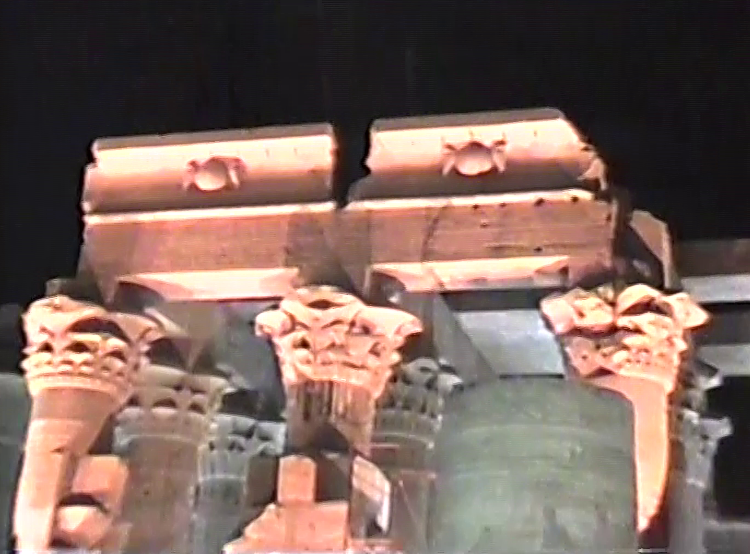 Temple of Kom Ombo at night
Temple of Kom Ombo at night
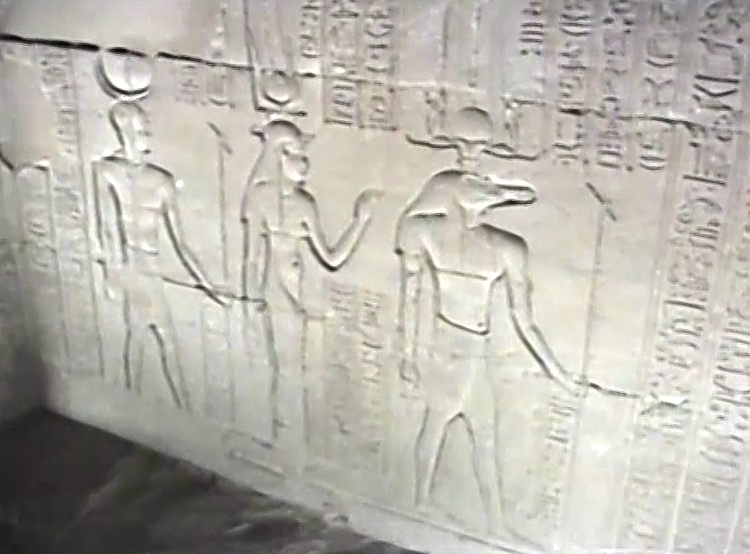 Temple of Kom Ombo, a detail, god Sobek with a crocodile head is on the right-hand side
Temple of Kom Ombo, a detail, god Sobek with a crocodile head is on the right-hand side
We also saw a wall relief that shows gods Thoth and Horus as they pour the water of life over a king, which is a relatively frequent motif. By the way, since I haven’t mentioned him so far and he is very important, let me just say that god Thoth is most often depicted in the human form with an ibis head. He was the inventor of numbers and letters, the messenger of gods, as well as the god of the Moon, wisdom, writing, science, magic, arts, etc.
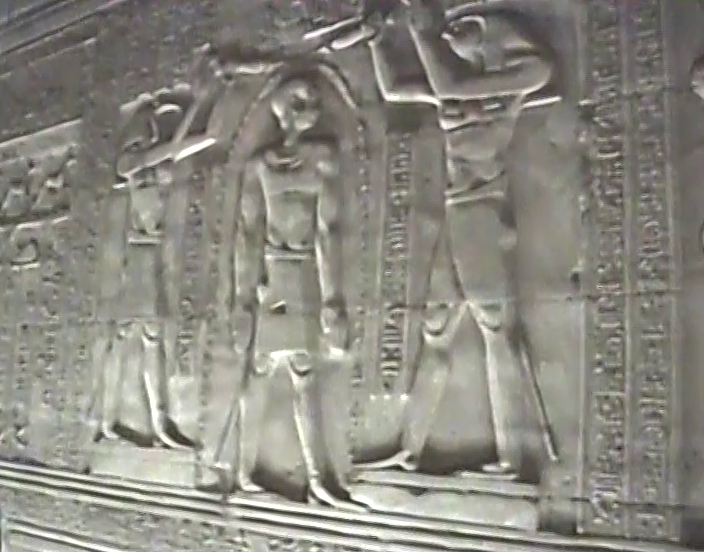 Temple of Kom Ombo, a detail, gods Thoth (left) and Horus (right) pouring the water of live of a king
Temple of Kom Ombo, a detail, gods Thoth (left) and Horus (right) pouring the water of live of a king
There was also the crowning of the king with two crowns – of Upper Egypt and of Lower Egypt. If you look at the next photo well, the figure on the left-hand side wears the (traditionally white) crown of Upper Egypt, while the figure on the right-hand side wears the (traditionally red) crown of Lower Egypt. The pharaoh in the middle wears the double crown called the pschent.
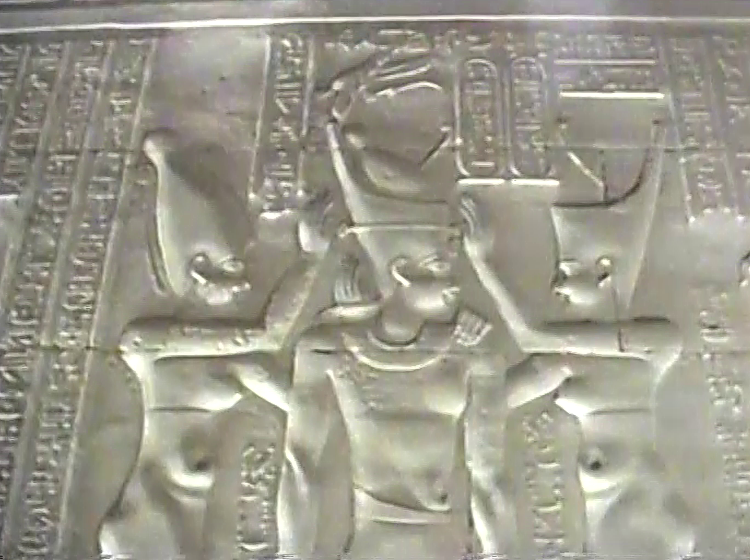 Temple of Kom Ombo, a detail, crowning of the pharaoh with a double crown
Temple of Kom Ombo, a detail, crowning of the pharaoh with a double crown
Here it was also possible to see a relief depiction of the Ancient Egyptian calendar that was primarily linked to the flood season, the harvest time, etc; in other words to agricultural activities, since the prosperity of the country first and foremost depended on that. Since the seasonal fluctuations of the Nile were of such a great importance, the visitors may also see a nilometre here which was used to measure the clarity of the Nile, as well as the levels of the water during the annual flood season.
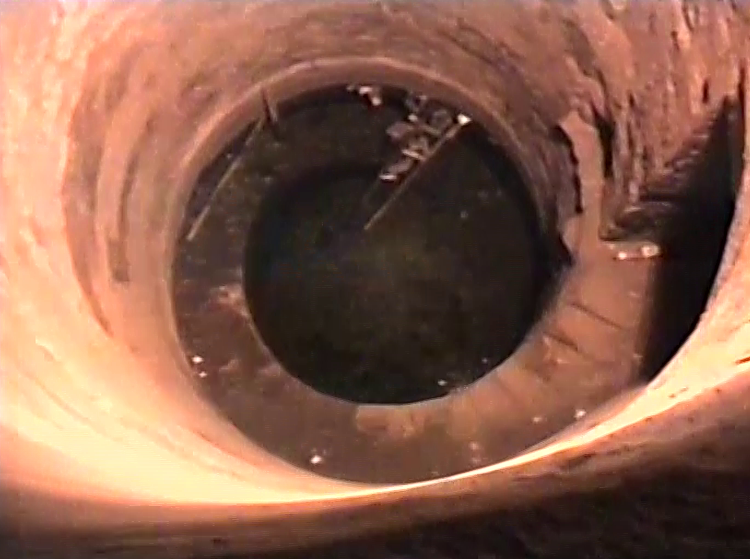 Nilometre at the Temple of Kom Ombo
Nilometre at the Temple of Kom Ombo
Agriculture was also linked to crocodiles, as well as to god Sobek himself to whom a part of this temple was dedicated. Namely, the Ancient Egyptians used to interpret an increased presence of crocodiles in the river (this was prior to the construction of Aswan High Dam) as a sign that the harvest would be good that year. Because of this, here, as well as around other Sobek shrines, they made a necropolis where they buried mummified crocodiles. Several specimens may be seen exhibited here within the temple.
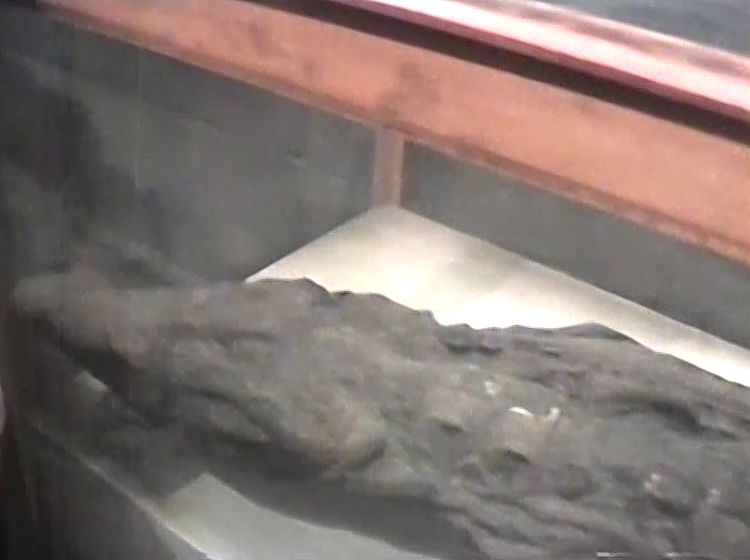 Mummified crocodile at the Temple of Kom Ombo
Mummified crocodile at the Temple of Kom Ombo
After this we went back to the ship and soon after was the time for dinner which was served in the buffet style and the offer was extremely good. But, following the advice of the then colleague who used to work as a tour guide in Egypt before, I was very careful what exactly I would take. Namely, this colleague told me back then that only “what has been cooked and what can be pealed” was safe. The problem lies in the water in which sometimes there are parasites. This can also apply to ships (and hotels) of high categories. In the case of ships, completely fine water is pumped into ship’s water tanks and these tanks are regularly topped up, but I presume because of the continuous “left-over” of the water from the previous pumping, there may appear parasites from time to time (I’m not saying this happens always and everywhere). The point is that I have often heard that people visiting Egypt have intestinal problems. Nothing too serious that cannot be regulated with standard medicines, but it may be quite dramatic while it lasts.
While we were having dinner, the ship was sailing on. As we were told, the plan was for the ship to move until 2 or 3 am when we were supposed to reach Edfu where the ship would dock.
Meanwhile, after the dinner, there was a relaxed sort of partying going on at the ship’s night club and the idea was for the passengers to wear galabeya (long dress traditionally worn by men and women alike). We had not been informed, but that would have made no difference. I found it interesting to observe our group from Serbia which was, in my opinion, during the whole trip exceptionally fun and unusually harmonious, and yet, very stiff in comparison to the groups from some other countries. Namely, when the music started, these other tourists let their hair down, so to speak, danced and had fun, while we all kept sitting firmly “glued” to our armchairs. We were even invited, enticed, but we stood our ground. It seemed to me we were way too inhibited and rigid, and I wondered why. Between us, we really had very good time, joking around and being laid back. Whether we are shy in this particular situation, insecure because of some language barriers or afraid we would “make a fool of ourselves” – I don’t know. And yet, although I had an impression that my group quite enjoyed being there, nobody from Serbia danced on the ship that night.
The next morning, the whole group got up very early, around 6 am, because the sightseeing plan included a visit to the Temple of god Horus in Edfu. The ship had already docked by the riverbank and everything was peaceful.
And then we were put into open carriages and transferred to the temple.
The temple in Edfu is the most famous temple to Horus and it was built between 237 and 57 BCE. God Horus is depicted either as a falcon or as a human figure with the head of a falcon and he is one of the most important Ancient Egyptian gods. It is interesting that over time the temple was buried under 12 metres of desert sand deposits and the sediments brought by the Nile. The clearing up started in the second half of the 19th century. Perhaps it is precisely because of this sand cover that the temple is also one of the best preserved – almost undamaged.
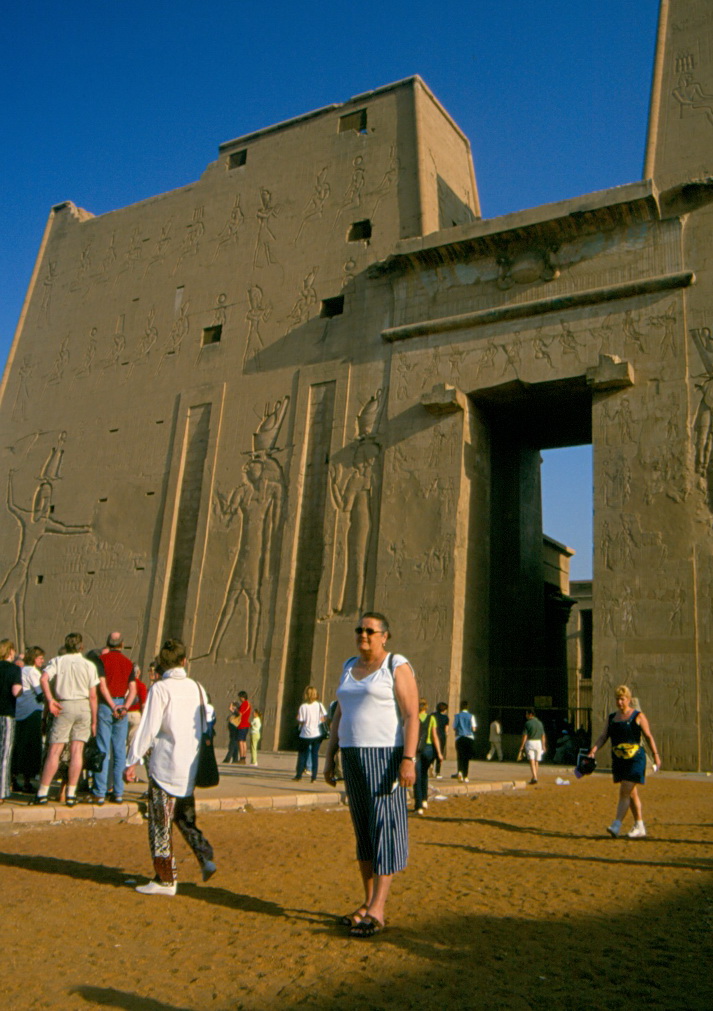 My mom in front of the Temple of Horus in Edfu
My mom in front of the Temple of Horus in Edfu
The site is a complex one and it comprises archaeological remains of different buildings, while the temple is only a part of the overall complex. Its front facade is done in the shape of a pylon, a monumental gate that consists of a doorway between two truncated pyramidal towers that appear more like a huge transversal wall that you go through in order to get to the temple’s courtyard.
The temple that has a rectangular ground plan is exceptionally opulently decorated and here I primarily think of its high walls and parts within the temple itself (the hypostyle halls and naos), as well as those that go around it. But, to start with, one first enters the courtyard.
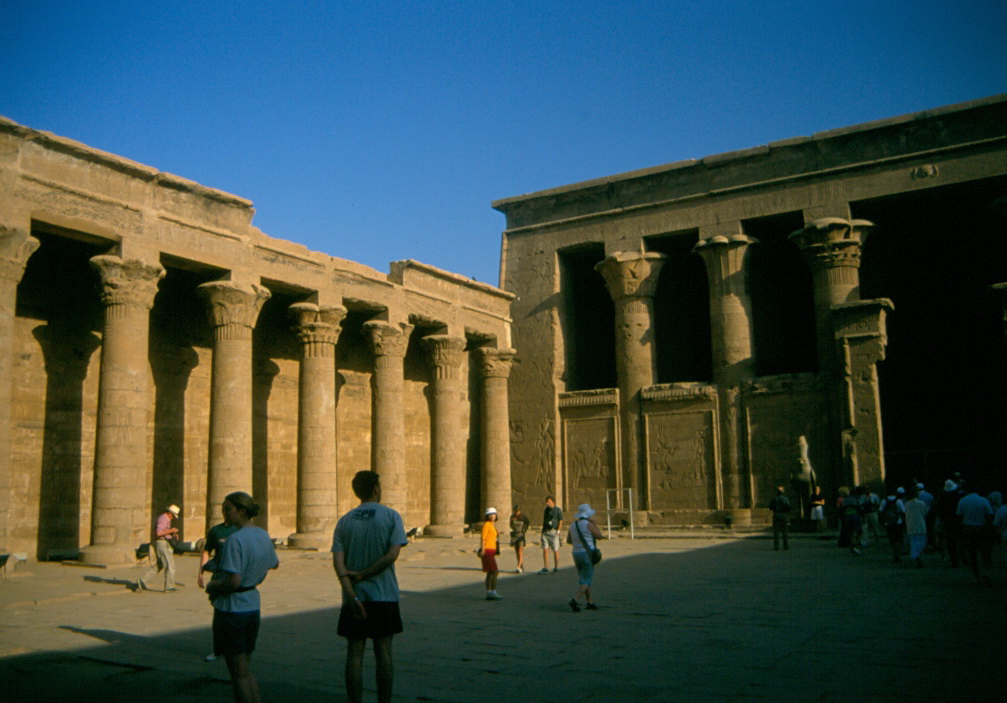 Courtyard of the Temple of Horus in Edfu – the entrance into the first hypostyle hall is to the right
Courtyard of the Temple of Horus in Edfu – the entrance into the first hypostyle hall is to the right
Beside the very entrance into the central part of the temple there is a statue of Horus in the shape of a falcon, while in a lot of places on the walls one can see depictions of the god in the shape of a human figure with a falcon head.
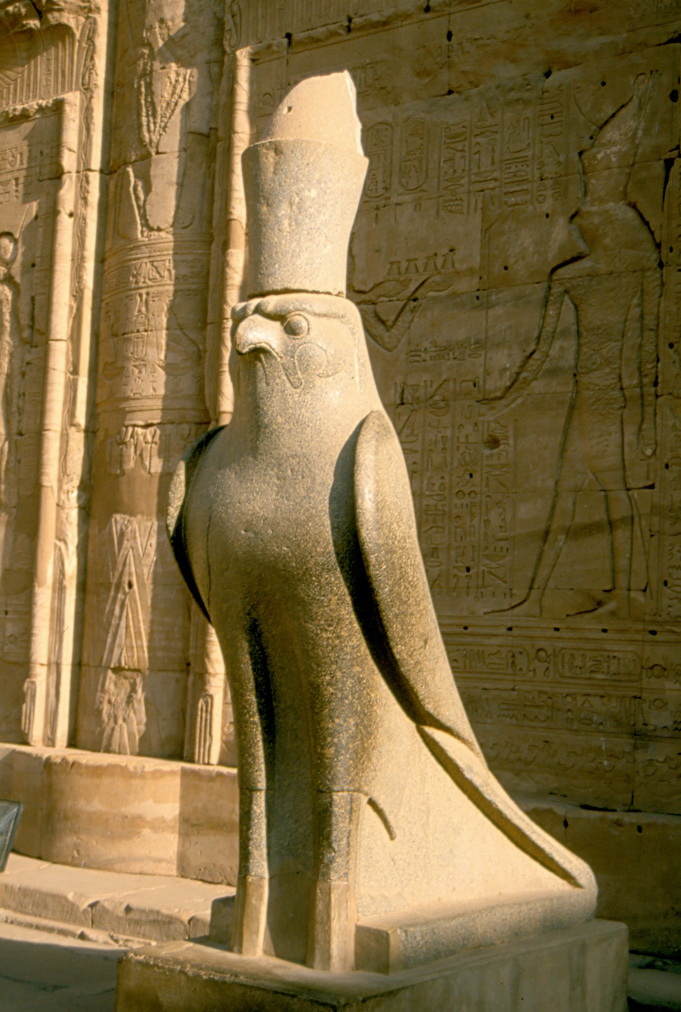 God Horus as a statue and on the wall
God Horus as a statue and on the wall
In order to get to the inner sanctum, the visitor first enters the first hypostyle hall, i.e., a hall with pillars, then the second hypostyle hall, the hall for offerings, a vestibule (anteroom or passage) and only then the naos, i.e., the inner sanctum. From the vestibule that also leads around the naos itself, one can enter numerous smaller chambers and chapels.
Although I was here on 22 March, i.e., a day after the Spring Equinox, during our visit there was obviously a ritual going on in one of the chambers, but there was an official guard in front of the doorway leading to this room, so we could only hear a very specific sound.
All of this may be seen and heard in the following video:
Afterwards we got into the open carriages again and so we returned to the ship. The cruise could continue, although we anchored at one moment by an island on the Nile. We all presumed that our ship advanced a little too much and now it needed to wait for its turn. Namely, we were getting close to the town of Esna and its lock.
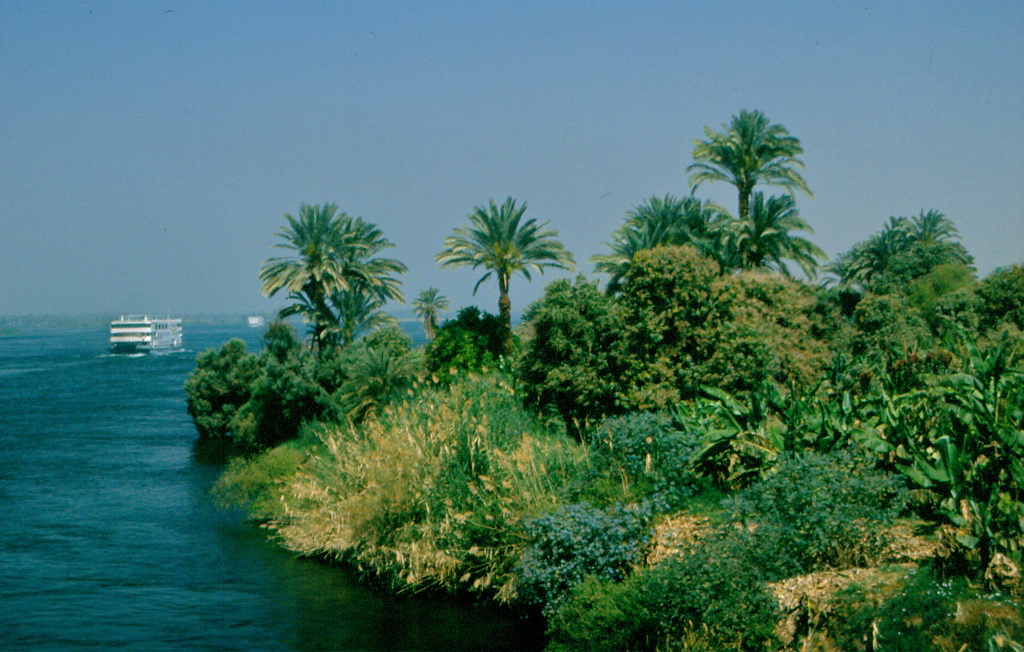 While some are cruising on, we are standing by a river island
While some are cruising on, we are standing by a river island
When we started to move, I enjoyed once again the lovely sights we were slowly cruising by.
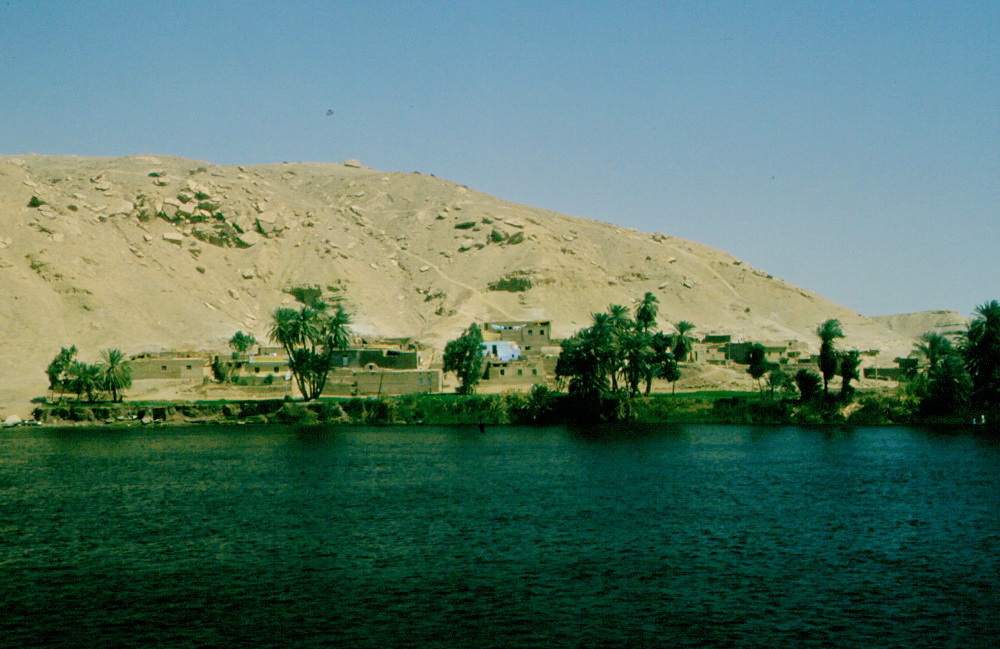 The Nile riverbank
The Nile riverbank
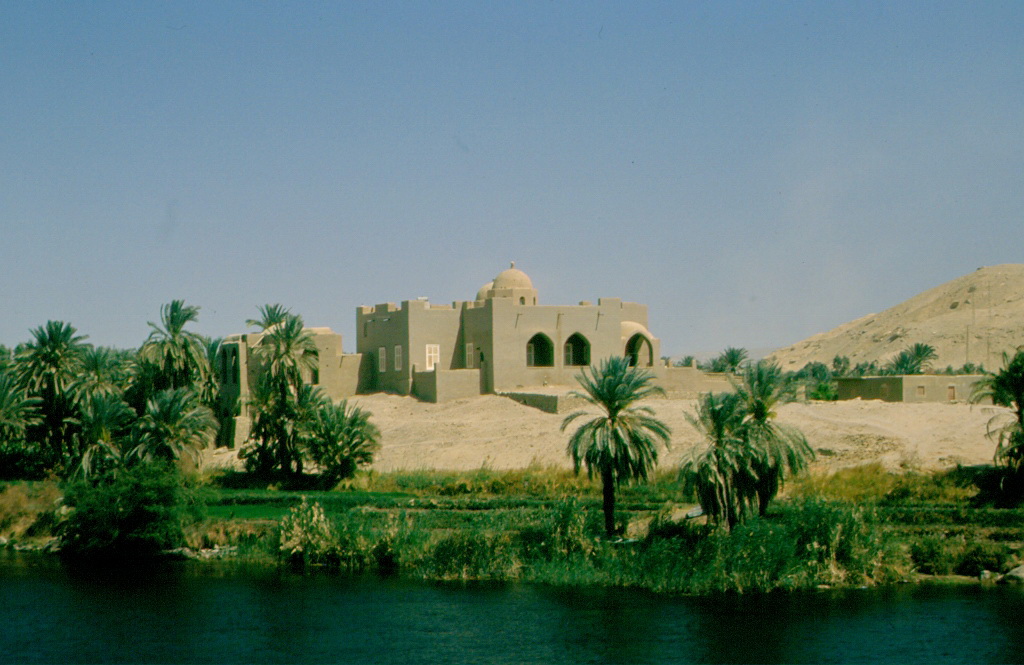 The Nile riverbank
The Nile riverbank
Esna is a town on the left bank of the Nile, around 55 km south of Luxor. There are two barrage bridges on the Nile in the town and for this reason large tourist ships must go through a lock system. When it’s crowded, this can take hours, since the ships must pass one by one. My impression was that there was some kind of order, a sequence, by which the ships were let pass through the lock and this was how we, as a group, interpreted the “parking” from earlier.
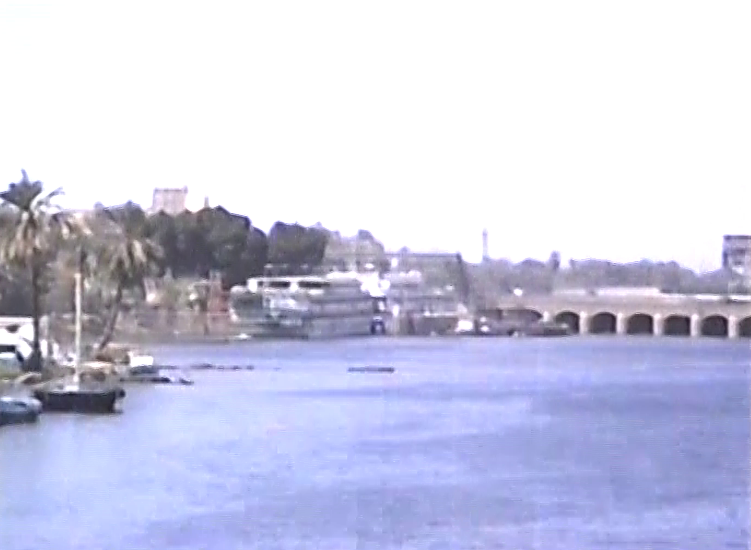 Esna: in the middle it may be discerned that there is a ship entering the lock, while a barrage bridge starts on the right-hand side of the photo
Esna: in the middle it may be discerned that there is a ship entering the lock, while a barrage bridge starts on the right-hand side of the photo
These two barrage bridges should not be mixed with the cataracts of the Nile. The latter are the places where the river is rather shallow, there are rocks coming out of it and so in such places white-water rapids form. There are six cataracts and they are located between Khartoum, the capital of Sudan, and Aswan.
Be as it may, it turned out that we waited rather long here and so, at some point, with a couple of younger people from the group, I got off the ship and went for a short walk around Esna.
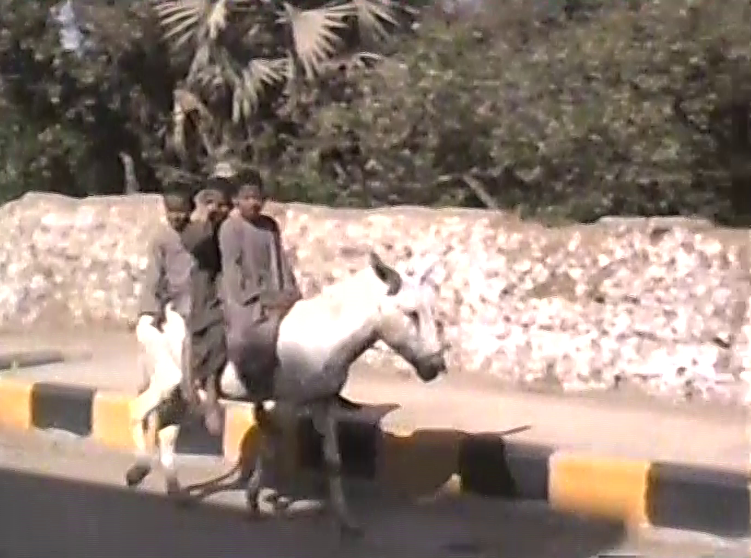 A detail from Esna
A detail from Esna
And so we got to a temple in Esna dedicated to god Khnum. This was one of the oldest deities in Ancient Egypt. He was originally the god of the source of the Nile and consequently he was associated with the river and its floods, but he was also considered the god creator of children whom he made out of clay on a potter’s wheel, after which he would put them into the wombs of the mothers. The god was usually depicted in the human form with the head of a ram with twisted horns that were placed horizontally.
The construction of the temple started already during the reign of pharaoh Thutmose III (1481-1425 BCE), but this first structure decayed over time and then the temple was restored during the reign of the Ptolemaic dynasty and the ancient Romans. Nowadays, its remains are situated in a kind of a big hole, i.e., the temple is around 9 m below the level of the contemporary streets.
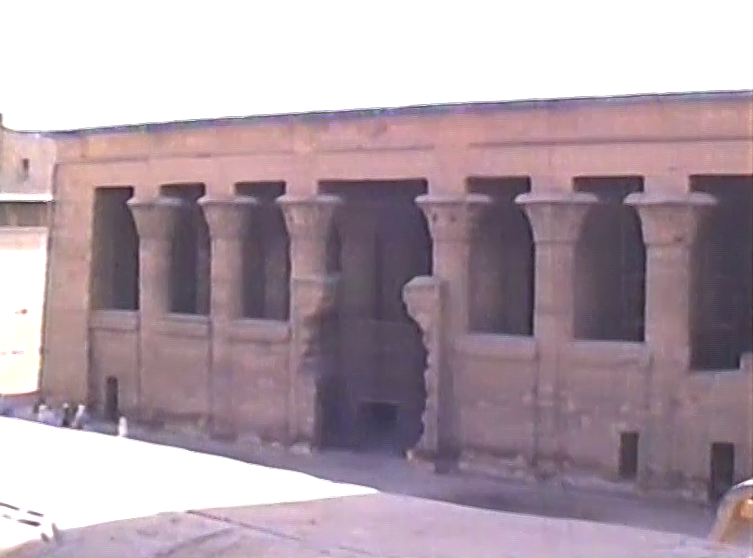 Temple in Esna
Temple in Esna
The temple was made of red sandstone, but in many places you can still see a lot of original colour. I found it particularly impressive that there was a lot of red colour. The reason is that many years ago I used to dye my hair red, so I know that as a civilisation we still cannot achieve good durability of the red hair-colour. And yet, the Ancient Egyptians used a red paint that has been exposed to all sorts of environmental impacts, including also being buried by the Nile mud, but still survives even after 2000 years.
Within the temple, there is a hypostyle hall with 24 columns that are around 11 high.
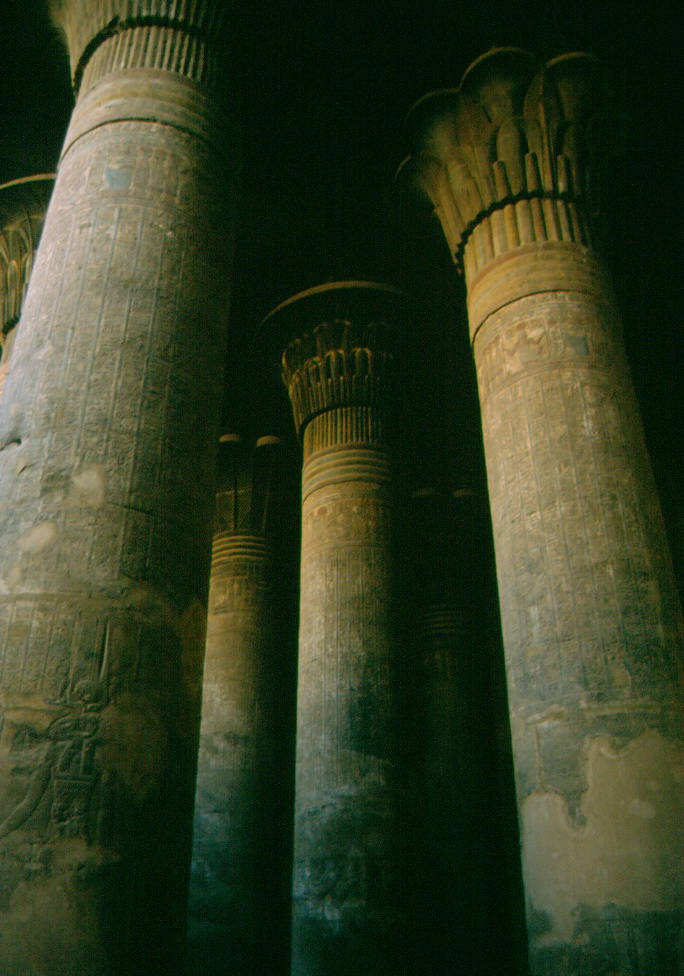 Temple in Esna
Temple in Esna
Afterwards we walked a little through a local market and then we returned to the ship. The wait was quite long and then the evening came.
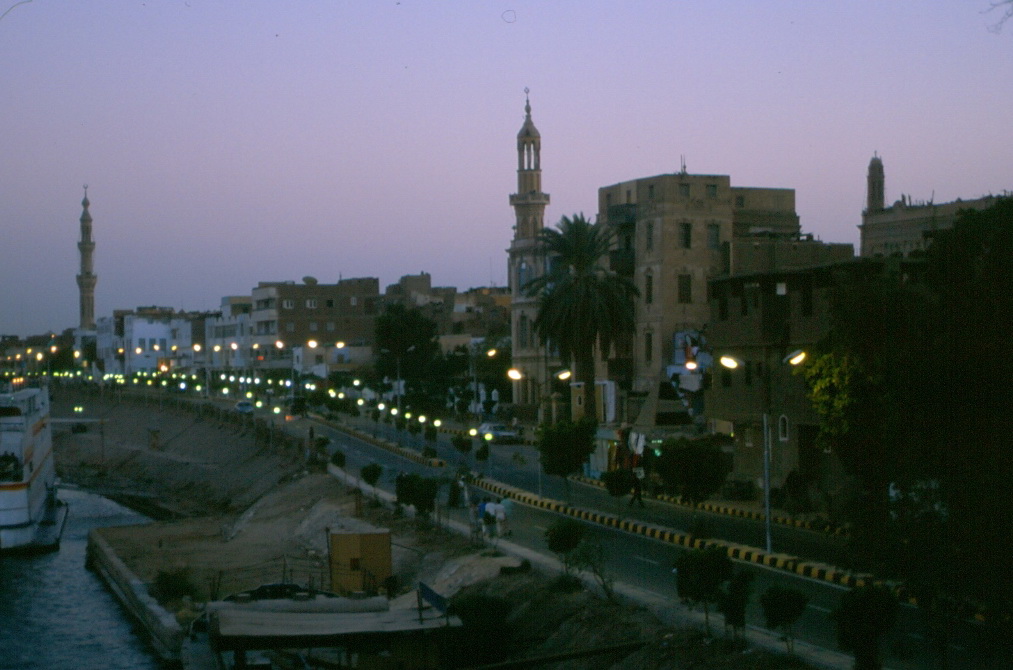 Esna – view from the ship
Esna – view from the ship
While we were waiting for the turn of our ship to proceed into the lock, after the dinner we were sitting on a terrace and it was completely dark outside. We were not alone, for there were also people from other groups and it seemed most of them were either French or German. I had seen a lot of them the previous night at the “party.” This time, it appeared that the situation was much calmer, but was it really? Namely, while we were waiting for our turn to go into the lock, a small boat appeared beside our big cruise ship and there were two men in that boat. One was rowing and the other one was doing the business. Specifically, they came there offering all sorts of goods, including also sofa decorative covers. But, the terrace we were sitting on was at least 5-6 metres above the level of the Nile on which their boat rocked slightly. As it turned out, this was not a problem at all – this guy who was in charge of the sale had strong arms and a sense for precise throwing. I think that any quarterback could envy him. So, the haggling went on along the up-and-down line, then the guy would throw a tightly packed sofa cover upwards, the customer would check the goods and then throw the money down, which the salesmen also caught quite skilfully. A lot of goods were sold that evening! And this was something that was equally enjoyed by members of all the nations that travelled on that ship.